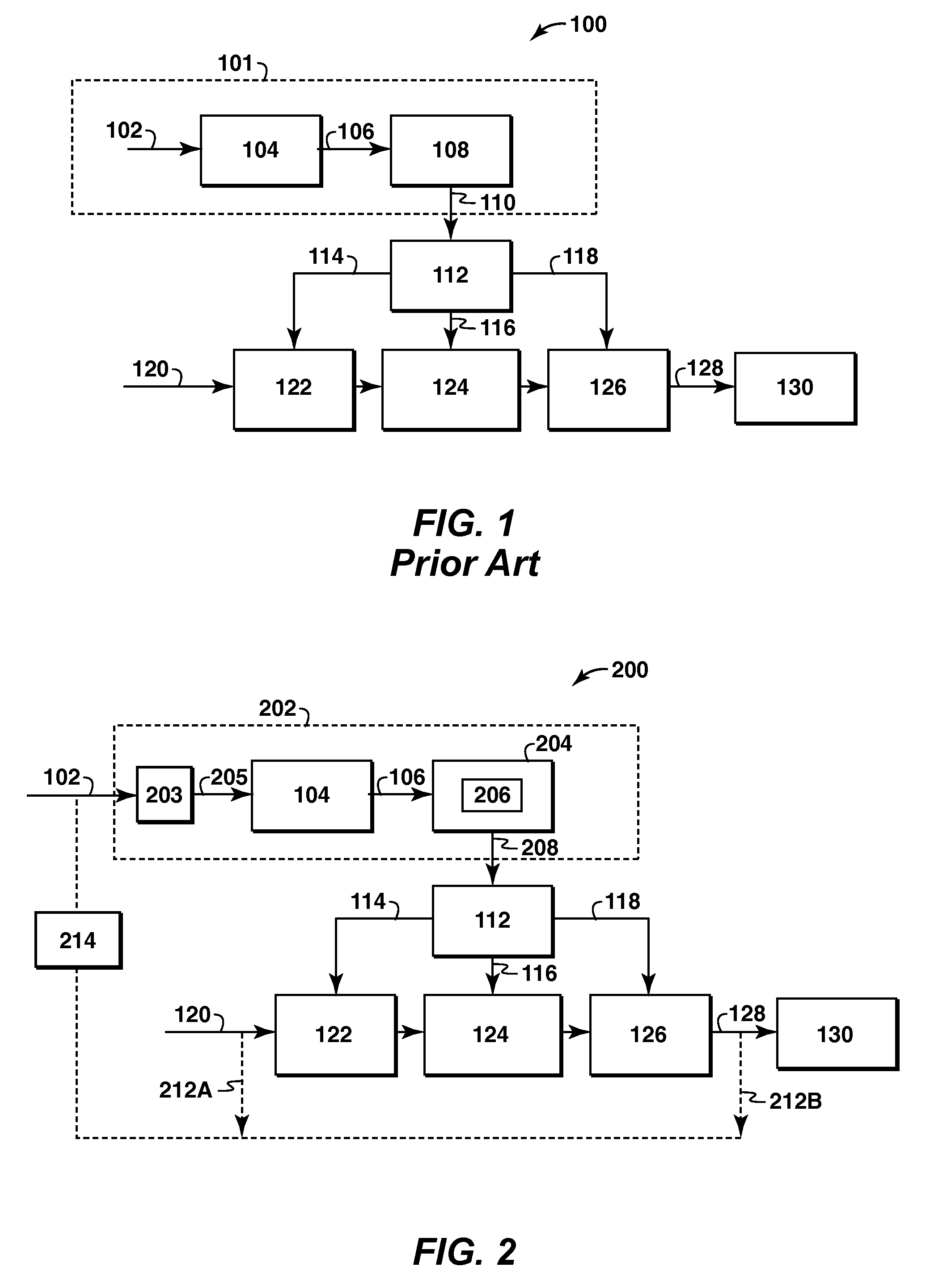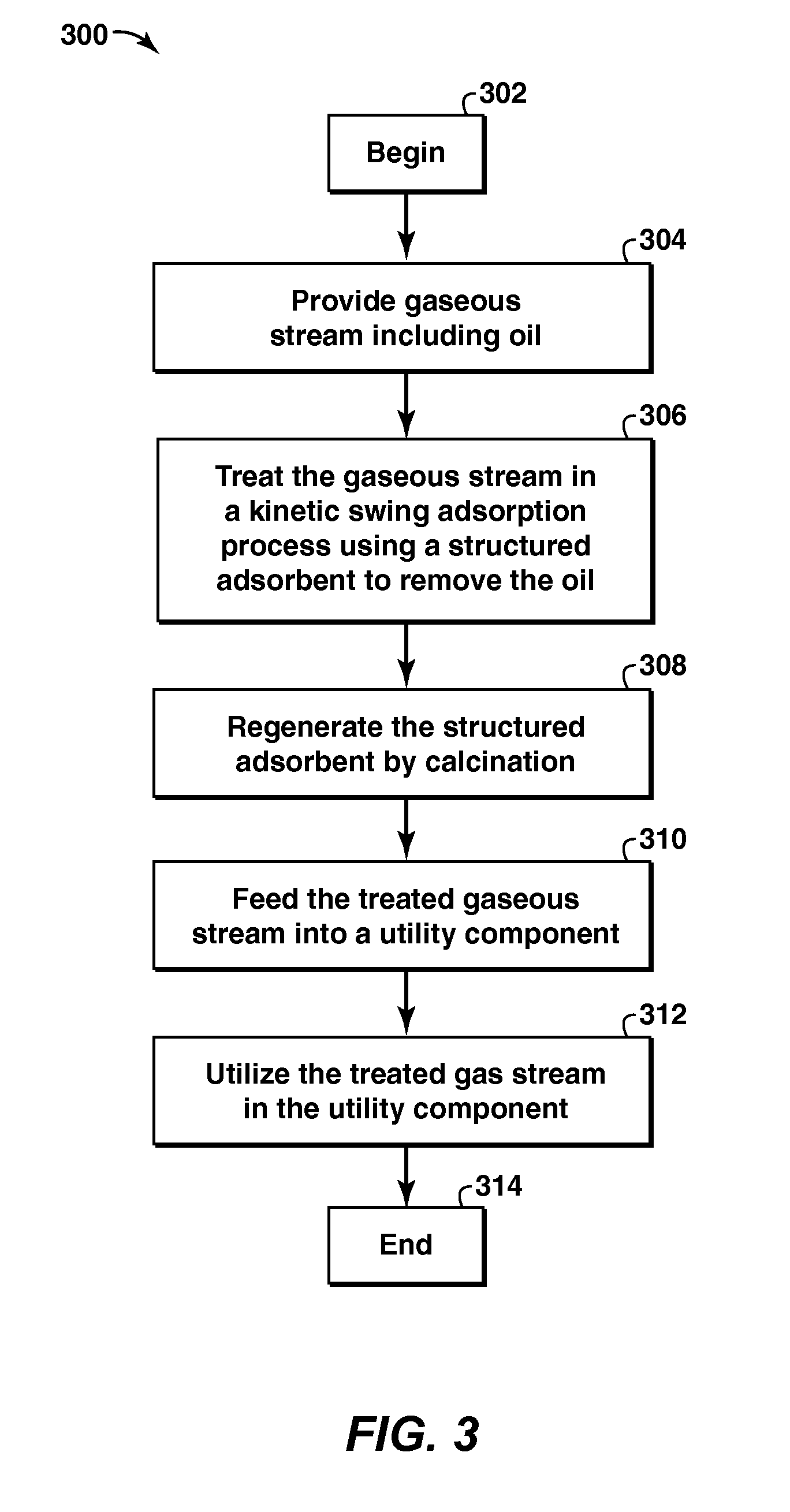Method and Apparatus For Removal Of Oil From Utility Gas Stream
- Summary
- Abstract
- Description
- Claims
- Application Information
AI Technical Summary
Problems solved by technology
Method used
Image
Examples
example 1
Example of Fuel Gas Composition that Will Not Condense in the Seals
[0085]Sources of seal gas can include any convenient extraction point in a gas production or treating process, such as at compressor discharge, as long as the discharge pressure is greater than the suction pressure of the compressor being sealed (i.e., the pressure needed to form a dry gas seal in a compressor). When the pressure of the gas is lowered (e.g., throttling across the seal), the temperature can drop such that some of the seal gas condenses.
[0086]FIG. 7 illustrates an exemplary graph comparing the phase envelopes of a treated seal gas and an untreated seal gas. The graph 700 relates pressure 702 in bar absolute (bara) and enthalpy 704 in kilo-calories per kilogram moles (kcal / kg·mol). A phase envelope of an untreated gas 706 is shown along with line 708 indicating an isenthalpic throttling of the untreated gas 706 across the seal. The exemplary seal gas 706 is taken from compressor discharge at 388 bara an...
example 2
[0088]The shape of the adsorption front that moves through a parallel channel contactor 500A during the oil adsorption step is modeled. This modeling used a competitive Langmuir isotherm to predict the loading of oil in the adsorbent 505. For the targeted adsorbents, the adsorption strength (e.g. selectivity) of the oil is expected to be so large that a sharp or shock wave like adsorption front moves through the contactor 500A. This type of behavior allows the adsorbent volume in the contactor 500A to be used efficiently, minimizing the adsorbent volume required and maximizing the length of an adsorption cycle.
[0089]This model simulates a single channel 504A of a solid adsorbent 506 without open mesoporous voids, open macropores, or heat adsorbing material. Due to symmetry it is sufficient to model a single channel 504A. The modeling follows an oil adsorption front that moves through the contactor 500A in an adsorption step 306 that follows after a calcination step 308. After the ca...
example 3
[0092]To establish conditions under which oil could be calcined, a 2 gram sample of mesoporous MCM-41 zeolite was loaded with about a 1,900 gram / mole polyglycol compressor oil. The zeolites were loaded by contacting the MCM-41 zeolite with the polyglycol oil in an amount close to incipient wetness. This required approximately 0.24 grams of oil. To further reduce the amount of oil that is not adsorbed in the zeolite the samples were placed in a vacuum oven and held at 125° C. for 12 hours at a pressure of less than 1 millimeter of mercury (mmHg)—about 0.00133 bar. When the samples were removed from the vacuum oven the amount of oil adsorbed was found to be greater than 10 wt % of the sample mass. To measure the rate at which this oil can be removed by calcination, thermogravimetric (TGA) experiments were performed. The batch of oil containing MCM-41 material was divided into about 2 to about 25 milligram (mg) samples that were repetitively placed in the TGA. The TGA was operated with...
PUM
| Property | Measurement | Unit |
|---|---|---|
| Temperature | aaaaa | aaaaa |
| Fraction | aaaaa | aaaaa |
| Pressure | aaaaa | aaaaa |
Abstract
Description
Claims
Application Information
 Login to View More
Login to View More - R&D
- Intellectual Property
- Life Sciences
- Materials
- Tech Scout
- Unparalleled Data Quality
- Higher Quality Content
- 60% Fewer Hallucinations
Browse by: Latest US Patents, China's latest patents, Technical Efficacy Thesaurus, Application Domain, Technology Topic, Popular Technical Reports.
© 2025 PatSnap. All rights reserved.Legal|Privacy policy|Modern Slavery Act Transparency Statement|Sitemap|About US| Contact US: help@patsnap.com



